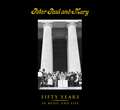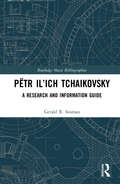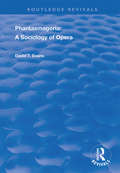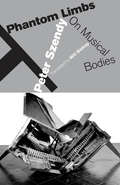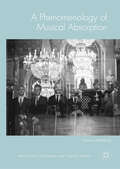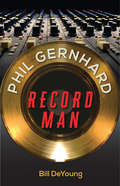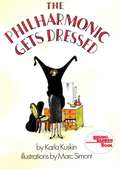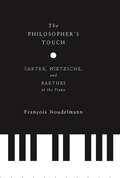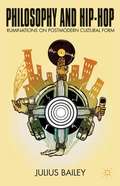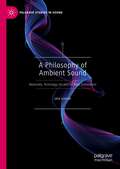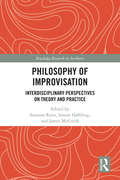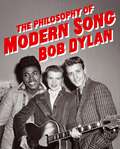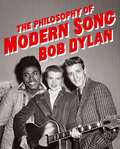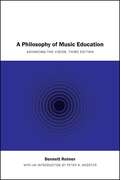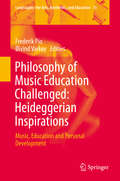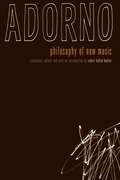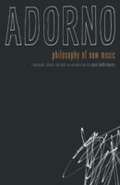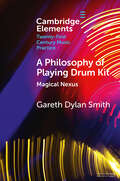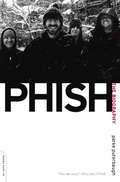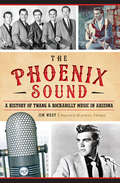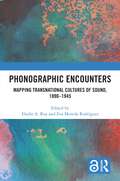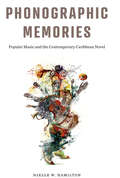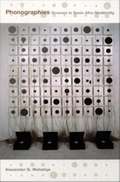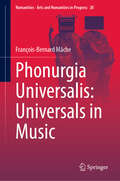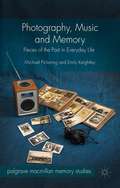- Table View
- List View
Peter Paul and Mary: Fifty Years in Music and Life
by Peter Yarrow Noel Paul Stookey Mary TraversThis carefully crafted and collectible volume tells the intimate story of Peter, Paul, and Mary and their music, in their words and with iconic images that follow their passionate, fifty-year journey to the center of America&’s heart. Photographs, many rare and never before published, taken over five decades by some of the world&’s top photographers, follow them from their earliest performances in the 1960s, when Mary was the most desired, beautiful, and charismatic performer and a new role model for women. Follow the trio as they lead America to discover the passionate soul of folk music. Join the struggle for racial equality, social justice, and freedom in this memorable journey, from the historic 1963 March on Washington with Martin Luther King, Jr., to the trio&’s appearance before a half million people in 1969 to end the Vietnam War, to their singing at the Hollywood Bowl for Survival Sunday in 1978, helping to launch the anti-nuke movement, the world&’s first international environmental movement. Through these images, readers will feel and almost hear the trio&’s songs calling for a more caring, better world as they performed with a courage and conviction that became for so many the embodiment and soundtrack of their generation&’s awakening to conscience, to activism, and to a new dream for all of humankind. Peter, Paul, and Mary&’s songs of defiant hope and a certain unmasked innocence are still a powerful part of our American consciousness, and this book reenacts the history of how the trio marked many lives with their indelible stamp of honesty of the sort we all yearn to recapture and recreate today—for ourselves, our children, and the generations to come.
Pëtr Il’ich Tchaikovsky: A Research and Information Guide (Routledge Music Bibliographies)
by Gerald R. SeamanPëtr Il’ich Tchaikovsky: A Research and Information Guide is an annotated bibliography of substantial, relevant published resources relating to the Russian composer. Generally regarded as one of the most remarkable composers of the second half of the nineteenth century, Tchaikovsky is unique in that he was the first outstanding Russian composer to receive a professional musical education, being one of the first students to graduate from the newly opened St. Petersburg Conservatory. Composer of six symphonies, concertos, orchestral works, eight major operas, three ballets, and many chamber, keyboard and vocal works, he also composed important sacred music, which is currently being reassessed by contemporary Russian musicologists who are able to examine materials previously restricted or inaccessible during the Soviet period. Like his colleagues in St. Petersburg, Tchaikovsky was deeply interested in Russian folk song, which plays an important part in his works. This volume evaluates the major studies written about the composer, incorporating new information that has appeared in literary publications, articles and reviews.
Phantasmagoria: Sociology of Opera (Routledge Revivals)
by David T. EvansFirst published in 1999, this original and entertaining sociological study takes a comprehensive and critical view of opera as unique cultural artefact as loss making ‘industry’, as institution with a ‘museum’ culture, and as consumed commodity of rare distinction and elaborate ritual. Specific chapters deal with opera within the contexts of musicological analysis, auratic art and fetishized taste: opera as business and as ‘museum’: singers’ opera: producers’ opera and audiences’ opera. There is also a chapter on ‘opera’: popular, commercialised fragments of opera outside the opera house, consumed by and through all manner of reproduced means: CD, video, Three Tenors concerts: film and TV soundtracks: advertising jingles etc. Despite the supposed popularisation and successful commercial exploitation of ‘opera’ during the past decade or so, this study concludes that opera remains an art-form, institution and ritual of relative inaccessibility and exclusiveness. The commercial interest in and profitability of ‘opera’ do not translate into new ‘popular’ audiences in the opera house. The increased dependency of opera companies on corporate funding in the face of retreating government subsidies may have brought a new ‘elite’ audience into the expensive seats, pandered to by the introduction of surtitles etc., but the traditional ‘elite’ has succeeded in closing down entry to opera in other select venues where opera continues to confirm and maintain their select identity and prestige of their life-style.
Phantom Limbs: On Musical Bodies
by Will Bishop Peter SzendyThe prostheses Peter Szendy explores—those peculiar artifacts known as musical instruments—are not only technical devices but also bodies that live a strange phantom life, as uncanny as a sixth finger or a third lung. The musicological impulse to inventory those bodies that produce sound is called into question here. In Szendy’s hands, its respectable corpus of scholarship is read aslant, so as to tease out what it usually prefers to hide: hybrids and grafts produced by active fictions, monsters, and chimera awaiting the opportunity to be embodied. Beyond these singular bodies that music composes and disposes there lies the figure of a collective “social” body ready to emerge amid an innervated apparatus that operates at a distance, telepathically. Phantom Limbs touches on bodies of all shapes and sizes that haunt the edges of music’s conceptualizations. Music continually reinvents such bodies and reconvenes them in new collective formations. It is their dynamics and crystallizations that Szendy auscultates on a motley corpus that includes Bach, Diderot, Berlioz, Eisenstein, Disney, and Monk.
A Phenomenology of Musical Absorption
by Simon HøffdingThis book presents a detailed analysis of what it means to be absorbed in playing music. Based on interviews with one of the world’s leading classical ensembles, “The Danish String Quartet” (DSQ), it debunks the myth that experts cannot reflect while performing, but also shows that intense absorption is not something that can be achieved through will, intention, prediction or planning – it remains something individuals have to be receptive to. Based in the phenomenological tradition of Husserl and Merleau-Ponty as well as of Dan Zahavi and Shaun Gallagher, it lays out the conditions and essential structures of musical absorption. Employing the lived experience of the DSQ members, it also engages and challenges core ideas in phenomenology, philosophy of mind, enactivism, expertise studies, musical psychology, flow theory, aesthetics, dream and sleep studies, psychopathology and social ontology, and proposes a method that integrates phenomenology and cognitive science.
Phil Gernhard, Record Man
by Bill DeYoungA go-getting, red-headed college kid eager to break into the music business, Phil Gernhard produced a handful of singles for South Carolina doo-wop group Maurice Williams and the Zodiacs. One of these songs, "Stay," reached number one on the charts in 1960. Gernhard was just 19 years old. Phil Gernhard, Record Man is the story of a self-made music mogul who created nearly fifty years' worth of chart-topping songs. From a tiny office and studio in Florida, he co-wrote the Royal Guardsmen's "Snoopy vs. the Red Baron," America's fastest-selling single of 1966. He revived the career of singer Dion DiMucci with the ballad "Abraham, Martin and John"--a million seller. He discovered and produced hit records for Lobo, Jim Stafford, and the Bellamy Brothers. Through a long collaboration with music business icon Mike Curb, he launched to fame many others, including country superstars Tim McGraw and Rodney Atkins. In Nashville and Los Angeles, Phil Gernhard was a legend. Yet Gernhard's private life was crumbling. He battled physical and emotional demons that he simply couldn't overcome, struggling with alcoholism, drug addiction, and a bad past with his father. He filed for his fourth divorce just months before taking his own life in 2008. Through interviews with Gernhard's musicians, business partners, family members, and ex-wives, Bill DeYoung offers an intimate portrait of a brilliant yet troubled man who channeled his talent, ego, and ambition into the success of others. A true "record man," Gernhard did it all. He lived to make records into gold, to make unknowns into stars, and above all, to make music.
The Philharmonic Gets Dressed
by Karla KuskinThe 105 members of the Philharmonic Orchestra get ready for a performance. For children.
The Philosopher’s Touch: Sartre, Nietzsche, and Barthes at the Piano (European Perspectives: A Series in Social Thought and Cultural Criticism)
by François NoudelmannRenowned philosopher and prominent French critic François Noudelmann engages the musicality of Jean-Paul Sartre, Friedrich Nietzsche, and Roland Barthes, all of whom were amateur piano players and acute lovers of the medium. Though piano playing was a crucial art for these thinkers, their musings on the subject are largely scant, implicit, or discordant with each philosopher's oeuvre. Noudelmann both recovers and integrates these perspectives, showing that the manner in which these philosophers played, the composers they adored, and the music they chose reveals uncommon insight into their thinking styles and patterns.Noudelmann positions the physical and theoretical practice of music as a dimension underpinning and resonating with Sartre's, Nietzsche's, and Barthes's unique philosophical outlook. By reading their thought against their music, he introduces new critical formulations and reorients their trajectories, adding invaluable richness to these philosophers' lived and embodied experiences. The result heightens the multiple registers of being and the relationship between philosophy and the senses that informed so much of their work. A careful reader of music, Noudelmann maintains an elegant command of the texts under his gaze and appreciates the discursive points of musical and philosophical scholarship they involve, especially with regard to recent research and cutting-edge critique.
Philosophy And Hip-hop
by Julius BaileyPhilosophy and Hip-Hop: Ruminations on Postmodern Cultural Form opens up the philosophical life force that informs the construction of Hip-hop by turning the gaze of the philosopher upon those blind spots that exist within existing scholarship. Traditional Departments of Philosophy will find this book a solid companion in Contemporary Philosophy or Aesthetic Theory. Inside these pages is a project that parallels the themes of existential angst, corporate elitism, social consciousness, male privilege and masculinity. This book illustrates the abundance of philosophical meaning in the textual and graphic elements of Hip-hop, and thus places Hip-hop within the philosophical canon.
A Philosophy of Ambient Sound: Materiality, Technology, Art and the Sonic Environment (Palgrave Studies in Sound)
by Ulrik SchmidtThis book presents the first book-length study of ambient sound as a key issue in sound studies and sonic philosophy. Taking a broad, media-philosophical approach, it explores ambient sound as a basic dimension of the sonic environment, sonic technologies, sonic arts and the material staging of listening.Through analyses of key concepts such as surroundability, mediatization, immanence, synthetization and continuous variation, the book elucidates how ambient aspects of sound influence our conceptions of what sound is and how it affects us by exposing sound’s relation to basic categories such as space, time, environment, medium and materiality. It also illuminates how the strategic production of ambient sound constitutes a leading aesthetic paradigm that has been a decisive factor in the shaping of the modern sonic environment – from key developments in experimental and popular music, sound art and cinematic sound design to the architectural-technological construction of listening spaces in concert halls and theaters and in current streaming infrastructures, digital surround sound and the everyday aesthetics of headphone listening.
Philosophy of Improvisation: Interdisciplinary Perspectives on Theory and Practice (Routledge Research in Aesthetics)
by Susanne Ravn; Simon Høffding; James McGuirkThis volume brings together philosophical and interdisciplinary perspectives on improvisation. The contributions connect the theoretical dimensions of improvisation with different viewpoints on its practice in the arts and the classroom. The chapters address the phenomenon of improvisation in two related ways. On the one hand, they attend to the lived practices of improvisation both within and without the arts in order to explain the phenomenon. They also extend the scope of improvisational practices to include the role of improvisation in habit and in planned action, at both individual and collective levels. Drawing on recent work done in the philosophy of mind, they address questions such as whether improvisation is a single unified phenomenon or whether it entails different senses that can be discerned theoretically and practically. Finally, they ask after the special kind of improvisational expertise which characterizes musicians, dancers, and other practitioners, an expertise marked by the artist’s ability to participate competently in complex situations while deliberately relinquishing control. Philosophy of Improvisation will appeal to anyone with a strong interest in improvisation, to researchers working in philosophy, aesthetics, and pedagogy as well as practitioners involved in different kinds of music, dance, and theater performances.
The Philosophy of Modern Song
by Bob DylanThe Philosophy of Modern Song is Bob Dylan&’s first book of new writing since 2004’s Chronicles: Volume One—and since winning the Nobel Prize for Literature in 2016. Dylan, who began working on the book in 2010, offers his extraordinary insight into the nature of popular music. He writes over sixty essays focusing on songs by other artists, spanning from Stephen Foster to Elvis Costello, and in between ranging from Hank Williams to Nina Simone. He analyzes what he calls the trap of easy rhymes, breaks down how the addition of a single syllable can diminish a song, and even explains how bluegrass relates to heavy metal. These essays are written in Dylan’s unique prose. They are mysterious and mercurial, poignant and profound, and often laugh-out-loud funny. And while they are ostensibly about music, they are really meditations and reflections on the human condition. Running throughout the book are nearly 150 carefully curated photos as well as a series of dream-like riffs that, taken together, resemble an epic poem and add to the work’s transcendence. In 2020, with the release of his outstanding album Rough and Rowdy Ways, Dylan became the first artist to have an album hit the Billboard Top 40 in each decade since the 1960s. The Philosophy of Modern Song contains much of what he has learned about his craft in all those years, and like everything that Dylan does, it is a momentous artistic achievement.
The Philosophy of Modern Song
by Bob DylanThe Philosophy of Modern Song is Bob Dylan’s first book of new writing since 2004’s Chronicles: Volume One—and since winning the Nobel Prize for Literature in 2016. <p><p> Dylan, who began working on the book in 2010, offers his extraordinary insight into the nature of popular music. He writes over sixty essays focusing on songs by other artists, spanning from Stephen Foster to Elvis Costello, and in between ranging from Hank Williams to Nina Simone. He analyzes what he calls the trap of easy rhymes, breaks down how the addition of a single syllable can diminish a song, and even explains how bluegrass relates to heavy metal. These essays are written in Dylan’s unique prose. They are mysterious and mercurial, poignant and profound, and often laugh-out-loud funny. And while they are ostensibly about music, they are really meditations and reflections on the human condition. Running throughout the book are nearly 150 carefully curated photos as well as a series of dream-like riffs that, taken together, resemble an epic poem and add to the work’s transcendence. <p><p> In 2020, with the release of his outstanding album Rough and Rowdy Ways, Dylan became the first artist to have an album hit the Billboard Top 40 in each decade since the 1960s. The Philosophy of Modern Song contains much of what he has learned about his craft in all those years, and like everything that Dylan does, it is a momentous artistic achievement.
A Philosophy of Music Education: Advancing the Vision, Third Edition
by Bennett ReimerBennett Reimer's A Philosophy of Music Education asserts that the nature and value of music education are determined primarily by the nature and value of music. Originally published in 1970 (with the third edition originally published in 2003), this text relates findings in the field of aesthetics to their implications for the practice of music education, thus emphasizing practical applications that students and future educators can employ in their teaching and learning. It addresses an increasingly diverse world in which music is viewed not as a singular practice but as a multitude of related practices. Reimer believes that music has characteristics that make it recognizably and distinctively a practice or an "art"; that these characteristics can be identified to a reasonable and useful degree (but no doubt never definitively); that music is of value to humans and their communities in a variety of ways related to these characteristics; and that the primary mission of music education is to make musical values widely and deeply available. Each chapter includes case studies ("Riffs") and questions for discussion/exploration ("Etudes") that enhance student learning. This reprint edition includes a new introduction by Peter R. Webster that sets Reimer's work in the context of the development of music education pedagogy and illuminates why this remains an important text for today's students. An excellent introductory text for undergraduate or more advanced music education students, A Philosophy of Music Education remains the best single introduction to this important and growing field.
Philosophy of Music Education Challenged: Heideggerian Inspirations
by Frederik Pio Øivind VarkøyThis volume offers key insights into the crisis of legitimization that music as a subject of arts education seems to be in. Music as an educational subject is under intense pressure, both economically, due to the reduction of education budgets, as well as due to a loss of status with policy makers. The contributions in this book illuminate Martin Heidegger's thinking as a highly cogent theoretical framework for understanding the nature and depth of this crisis. The contributors explore from various angles the relationship between the pressure on music education and the foundations of our technical and rationalized modern society and lead the way on the indispensable first steps towards reconnecting the cultural practices of education with music and its valuable contributions to personal development.
Philosophy of New Music
by Theodor W. AdornoAn indispensable key to Adorno&’s influential oeuvre—now in paperbackIn 1949, Theodor W. Adorno&’s Philosophy of New Music was published, coinciding with the prominent philosopher&’s return to a devastated Europe after his exile in the United States. Intensely polemical from its first publication, every aspect of this work was met with extreme reactions, from stark dismissal to outrage. Even Arnold Schoenberg reviled it. Despite the controversy, Philosophy of New Music became highly regarded and widely read among musicians, scholars, and social philosophers. Marking a major turning point in his musicological philosophy, Adorno located a critique of musical reproduction as internal to composition, rather than a matter of musical performance. Consisting of two distinct essays, &“Schoenberg and Progress&” and &“Stravinsky and Reaction,&” Philosophy of New Music poses the musical extremes in which Adorno perceived the struggle for the cultural future of Europe: between human emancipation and barbarism, between the compositional techniques and achievements of Schoenberg and Stravinsky. In this translation, which is accompanied by an extensive introduction by distinguished translator Robert Hullot-Kentor, Philosophy of New Music emerges as an essential guide to the whole of Adorno's oeuvre.
Philosophy of New Music
by Robert Hullot-Kentor Theodor W. AdornoIn 1947 Theodor Adorno, one of the seminal European philosophers of the postwar years, announced his return after exile in the United States to a devastated Europe by writing Philosophy of New Music. Every aspect of this work was met with extreme reactions, from stark dismissal to outrage. Despite the controversy, Philosophy of New Music became highly regarded and widely read among musicians, scholars, and social philosophers.
A Philosophy of Playing Drum Kit: Magical Nexus (Elements in Twenty-First Century Music Practice)
by Gareth Dylan SmithThe author is a drummer with experience in a variety of musical genres and contexts, with emphasis on rock and related styles. This auto ethnographic Element presents the author's philosophy of playing drum kit. The text explains how playing drum kit matters to this musician and may resonate with others to whom making music matters in similar ways. The Element contains audio files of music in which the author plays drum kit in the ensemble settings described. There are photos of the author's drums and of him drumming. Based on June Boyce-Tillman's non-religious model of holistic spirituality and Tim Ingold's notion of correspondences, the author describes how playing drum kit enables him to experience transcendence – the magical nexus at which Materials, Construction, Values/Culture and Expression meet. Each of these domains, and the magic derived from their combination, is illustrated through examples of the author's live and recorded musical collaborations.
Phish: The Biography
by Parke PuterbaughDrawing upon nearly fifteen years of exclusive interviews with the members of Phish, veteran music journalist Parke Puterbaugh examines the colorful chemistry that inspired the wildly popular rock group to push their four-man experiment to the limit. An intimate and fascinating portrait,Phish: The Biographyis the definitive story of these Vermont jam-band legends.
The Phoenix Sound: A History Of Twang And Rockabilly Music In Arizona
by Jim WestIn 1956, a fresh-faced Sanford Clark recorded "The Fool" with guitarist Al Casey at Floyd Ramsey's small Phoenix recording studio. Written by local deejay Lee Hazlewood, the song became a top-ten Billboard hit nationwide and launched a new trailblazing era of Arizona music. Their success paved the way for other Phoenix acts and producers to chart national hits. Grammy-winning audio engineer Jack Miller started out in Ramsey's studio, and Hazlewood produced rock hall of famer Duane Eddy's debut album, Have "Twangy" Guitar, Will Travel. These early artists pioneered a sound that inspired Arizona's best musicians from Waylon Jennings and Buck Owens to Stevie Nicks and Linda Ronstadt. Join former radio and broadcast personality Jim West for the story and soundtrack to the early days of music in the Valley of the Sun.
Phonographic Encounters: Mapping Transnational Cultures of Sound, 1890-1945
by Elodie A. Roy Eva Moreda RodríguezThis cross-disciplinary volume illuminates the history of early phonography from a transnational perspective, recovering the myriad sites, knowledge practices, identities and discourses which dynamically shaped early recording cultures. With case studies from China, Australia, the United States, Latin America, Russia, Sweden, Germany, Spain, Portugal, France, and Italy, Phonographic Encounters explores moments of interaction and encounter, as well as tensions, between local and global understandings of recording technologies. Drawing on an array of archival sources often previously unavailable in English, it moves beyond western-centric narratives of early phonography and beyond the strict confines of the recording industry. Contributions from media history, musicology, popular music studies, cultural studies, area studies and the history of science and technology make this book a key and innovative resource for understanding early phonography against the backdrop of colonial and global power relations.
Phonographic Memories: Popular Music and the Contemporary Caribbean Novel (Critical Caribbean Studies)
by Njelle W. HamiltonPhonographic Memories is the first book to perform a sustained analysis of the narrative and thematic influence of Caribbean popular music on the Caribbean novel. Tracing a region-wide attention to the deep connections between music and memory in the work of Lawrence Scott, Oscar Hijuelos, Colin Channer, Daniel Maximin, and Ramabai Espinet, Njelle Hamilton tunes in to each novel’s soundtrack while considering the broader listening cultures that sustain collective memory and situate Caribbean subjects in specific localities. These “musical fictions” depict Caribbean people turning to calypso, bolero, reggae, gwoka, and dub to record, retrieve, and replay personal and cultural memories. Offering a fresh perspective on musical nationalism and nostalgic memory in the era of globalization, Phonographic Memories affirms the continued importance of Caribbean music in providing contemporary novelists ethical narrative models for sounding marginalized memories and voices. Njelle W. Hamilton's Spotify playlist to accompany Phonographic Memories: https://spoti.fi/2tCQRm8
Phonographies: Grooves in Sonic Afro-Modernity
by Alexander G. WeheliyePhonographies explores the numerous links and relays between twentieth-century black cultural production and sound technologies from the phonograph to the Walkman. Highlighting how black authors, filmmakers, and musicians have actively engaged with recorded sound in their work, Alexander G. Weheliye contends that the interplay between sound technologies and black music and speech enabled the emergence of modern black culture, of what he terms "sonic Afro-modernity. " He shows that by separating music and speech from their human sources, sound-recording technologies beginning with the phonograph generated new modes of thinking, being, and becoming. Black artists used these new possibilities to revamp key notions of modernity--among these, ideas of subjectivity, temporality, and community. Phonographies is a powerful argument that sound technologies are integral to black culture, which is, in turn, fundamental to Western modernity. Weheliye surveys literature, film, and music to focus on engagements with recorded sound. He offers substantial new readings of canonical texts by W. E. B. Du Bois and Ralph Ellison, establishing dialogues between these writers and popular music and film ranging from Louis Armstrong's voice to DJ mixing techniques to Darnell Martin's 1994 movie I Like It Like That. Looking at how questions of diasporic belonging are articulated in contemporary black musical practices, Weheliye analyzes three contemporary Afro-diasporic musical acts: the Haitian and African American rap group the Fugees, the Afro- and Italian-German rap collective Advanced Chemistry, and black British artist Tricky and his partner Martina. Phonographies imagines the African diaspora as a virtual sounding space, one that is marked, in the twentieth century and twenty-first, by the circulation of culture via technological reproductions--records and tapes, dubbing and mixing, and more.
Phonurgia Universalis: Universals in Music (Numanities - Arts and Humanities in Progress #28)
by François-Bernard MâcheThis translation of Musique au singulier (2001) from the French identifies what is common to music of all times and cultures. The author, François-Bernard Mâche is a composer and internationally renowned musicologist. He addresses the question of universals in music and demonstrates how musical play is a poetic and natural game that already takes shape in the animal world. Mâche invites the reader to reconsider the traditional opposition between nature and culture and to reflect on experiencing such intense emotions when both listening to and manipulating sounds. This title appeals to students and researchers working in musicology.
Photography, Music and Memory: Pieces of the Past in Everyday Life (Palgrave Macmillan Memory Studies)
by Michael Pickering Emily KeightleyThis book explores how photography and recorded music act as vehicles or catalysts in processes of remembering, and how they are regarded, treated, valued and drawn upon as resources connecting past and present in everyday life. It does so via two key concepts: vernacular memory and the mnemonic imagination.
